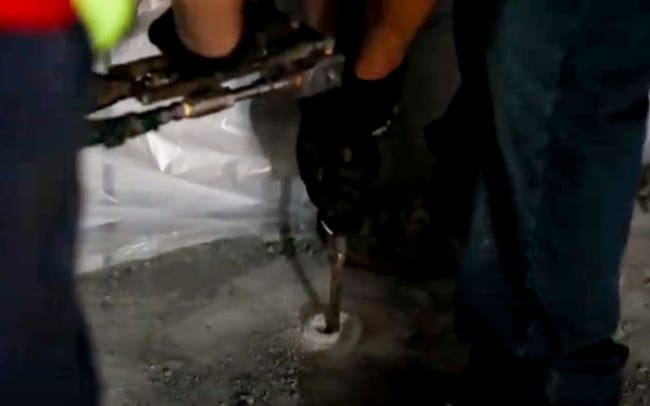
While this blog is written for builders and contractors, the deep injection method also has practical applications in residential settings. This article is written with the assumption you are already familiar with our slabjacking process and makes multiple references to it. If this is not the case for you, I would recommend reading our blog that explains how slabjacking works, first.
I don’t know about you, when I heard “deep injection” the first time, I thought of an unpleasant dental procedure like a root canal or gum cleaning (yes, sorry, but I hate dentists). But even if you’re a knowledgeable and experienced contractor, you may not have heard much about deep injection until recently.
This is because one specific company had a method patent on the deep injection process; their exclusive rights ended in late 2017. As soon as that patent expired, Acculevel upgraded our equipment and trained our premier slabjacking crew in this new process. We chose the slabjacking crew because the repair methods of slabjacking and deep injection have significant overlap. These two repair methods don’t solve the same problems- but their application processes are similar.
Acculevel has been repairing foundations and lifting concrete for more than 20 years. Andy Beery founded the company in 1996; it’s always been a family business, with his two sons coordinating the sales team and installation crews. In this article, we’ll explain how the deep injection process works, how it can be used effectively to stabilize a foundation, and what circumstances make it a poor fit.
As I mentioned, the installation method overlaps with slabjacking. I am assuming you are already well-versed in slabjacking as a concrete lifting method. If you’re not, or would like a quick refresher, this article will give you an overview of how it compares to mudjacking.
It uses some of the same equipment as slabjacking, but serves a very different purpose. Here’s a side-by-side comparison:
| Deep Injection | Slabjacking |
| Uses a two-part polyurethane foam | Uses a two-part polyurethane foam |
| Injected by hose through a pipe | Injected by hose into a port |
| Requires a hole ¾ inch diameter | Needs a ⅜ inch diameter hole |
| Can be used for void fill deep underground | Is meant to be used for shallow void fill |
| Usually not designed for lift | Predominantly used to lift concrete slabs |
What if your client needs both lift and stabilizations? Is it possible to combine the two? Absolutely. Let’s say you have a warehouse with a sinking corner. You need to stop the erosion, stabilize the soil deeper under the building, and lift it back up. We would recommend using deep injection to stop the material erosion, then slabjacking the same area to lift the floor.
When the two foams are combined in deep injection, they become a strong adhesive material. This means the process has a number of practical applications on a construction site:
If the structure you’re repairing needs additional shoring or support, deep injection is an excellent alternative to traditional methods. It’s significantly faster and less expensive than sheet piling, installing tiebacks, or lagging.
It’s also more versatile than other shoring methods because it can be done in a more confined space without excavation. The injection pipes can be attached to the truck through a hose, allowing the injection to be done where equipment access is limited. At Acculevel, we have a 200-foot hose, so we can be parked a considerable distance away from the site and still accomplish the task.
I mentioned earlier that it’s not meant for lift. This makes deep injection an ideal fit for existing structures that need shoring but should not be lifted.
Deep injection is a combination of lightweight foams. This makes it highly effective in granular or loose soil compositions. But it will not be effective in dense or heavily compacted soil.
If a building has utilities that need to be maintained like ductwork or pipes, deep injection may not be a good fit. This is because the injection foam flows easily along the paths of least resistance. It will fill any and all crevasses, making it difficult (or impossible) to access those utilities later.
Do you have an upcoming project that you think needs shoring, soil compaction, or concrete lifting? Are you looking for a reputable and trustworthy company to collaborate with? You can rely on our training and experience to resolve whatever foundation issues you encounter on a jobsite. Send us your project details and we’ll find the most efficient and economical way to meet your goals. Please email office@acculevel.com with the following:
We look forward to working with you!
[DISPLAY_ULTIMATE_SOCIAL_ICONS]